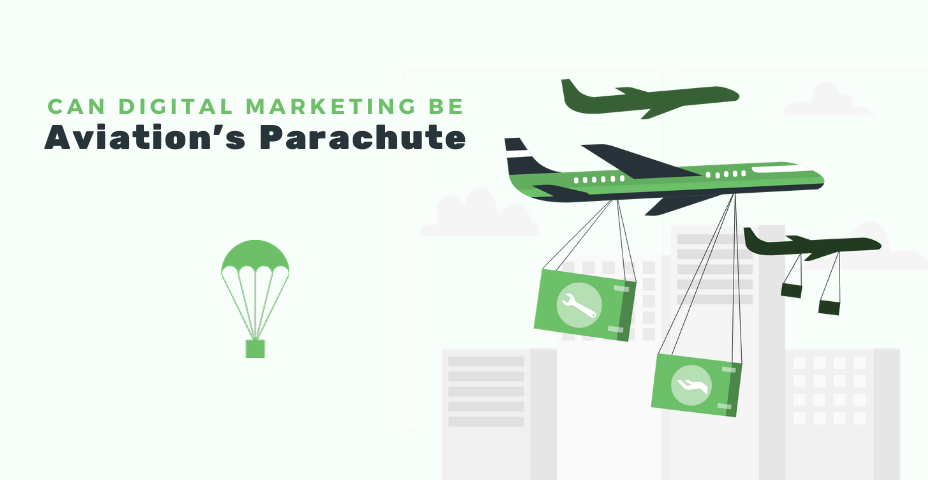Due to the ongoing COVID-19 pandemic, international flights are strictly limited and executed under certain rules. That has forced many airlines to ground a large portion of their fleet, which has led the aviation industry into a state of free fall.
While falling towards the abyss of financial crisis and bankruptcy, some companies pulled their primary ripcord. They shrunk their expenses by selling assets, subsidiaries, and even letting go of their secondary personnel.
But for most, these measures weren’t enough. They were a temporary patch that only slowed their falling. Now they are looking for the auxiliary ripcord (a safety measure on all parachutes in case the primary malfunctions) and digital marketing may just be that for them.
The Impact of COVID-19 on Aviation
The Market Will Need Years to Recover
Before the COVID-19 pandemic, the aviation industry was soaring. New airports were being built, technology was advancing, and the demand for both passenger and cargo flights was on the uprise.
However, all this changed on March 11 when the World Health Organization (WHO) declared a global pandemic. During the next few days, many countries closed their borders. Some took even more drastic measures and banned all international flights indefinitely.
This forced many aviation companies to ground their planes and announce restrictive measures. Studies show that the reduction in air traffic for the upcoming months will be between 48% and 61%. They predict that most airlines, especially the ones serving Europe, will lose at least 50% of their annual turnover.
These numbers are frightening and rightly so. They will create a domino effect that will impact almost every business sector in the world. In fact, most experts speculate that it may take more than a decade for the aviation industry to return to pre-crisis levels.
Only Adaptive Companies Will Survive the Crisis
Airlines Must Accept the New Reality
Even before the pandemic, the aviation industry was changing. Audience preferences were shifting heavily towards personalization while innovations in communication were closing the gap between airlines and their passengers.
These changes almost seem prophetic, as now more than ever people would want personalized services from airlines. They will also expect a prompt check-in procedure that will enable them to quickly board their flights without having to wait long lines and putting themselves in harm’s way. I know I would.
What better to promote individual packages, and a newer and quicker boarding procedure than using social media, the Internet, and other online features. Furthermore, airlines and airports can use online polls to learn exactly what people expect of them so they can make adequate and satisfactory alterations.
Only companies who can meet these demands will be able to decelerate their free fall and give themselves enough time to pull their secondary ripcord.
How Can Digital Marketing Help
Brand Loyalty Is the First Step to Recovery
Passenger airlines relied heavily on costly television advertisements to promote their services. The emergence of social media and digital marketing offers aviation companies more options to publicize their products.
Nowadays, people are naturally gravitating towards content that has a narrative. Storytelling can enable airlines to make their brand more relatable. That creates a stronger relationship with customers.
Replacing big-budget television ads with cost-effective and engaging content is an excellent strategy to reduce expenses and still promote their services to a large target audience.
Collaboration Will Allow More to Survive
Pooling Resources
Airlines rarely work together but extraordinary circumstances require extraordinary solutions. Pooling their resources will allow them to stay united in the face of crisis. It will also set up an example to other industries that are on the verge of collapse.
Social media can be used to spread the message for unity. This will showcase the industry’s moral values. And will send a clear message that airlines are prepared to set aside their differences to ensure the safety, comfort, and necessities of their customers.
Working together is an excellent scheme that can easily be promoted via online marketing. It’s also a plan of action that will reduce the industry’s financial burdens and perhaps improve the airport experience, which we all know is stressful enough as it is.
Email Marketing Can Make a Difference
Information Must Be Accessible and Personalized
Miscommunication is the Achilles heel of any business. It costs money, time, and productivity. That is why it should be avoided, especially in times like these.
Email marketing is an effective strategy that enables companies to present an informational portfolio to designated inboxes. Airlines can use emails to build trust, loyalty, and brand awareness.
Sending well-written emails at the right time to the right audience will allow aviation companies to gain sales without investing large sums into promotional events, televised advertisements, and other expensive physical marketing techniques.
Social Media Can Build Brand Equity
Being Active on Social Media Can Generate Revenue
Passengers share their flight experience on social media. They post pictures before take-off and after landing, while getting their luggage, and when they leave the airport. This phenomenon can be used by aviation companies to build brand equity.
KLM is a perfect example of how an airline can generate $25 million in revenue by being active on social media. Their “Meet & Seat” campaign enabled fliers to choose seats alongside passengers with whom they have similar interests.
Social media users are highly engaged with the companies they follow. They love to see their content reposted and engaged with. Being active on social media does more than building brand equity and generating revenue, it also creates brand loyalty.
Visual Content Is Worth More Than a Thousand Words
Know Your Target Group
It may come as a surprise but millennials travel more and spend more than any other age group. That is why airlines should focus on marketing schemes that appeal to young travelers. 60% of them understand information when it’s communicated visually.
As a copywriter at a content writing agency, I understand the weight of words. However, I also know that often pictures are worth more than a thousand words.
Integrating visual content and user-generated galleries can help airlines gain new customers without spending a vast portion of their budget.
The world is too dependent on the aviation industry for it to collapse entirely. People will still want to travel and visit new places. But not all companies will survive the crisis. Only the ones with a well-designed and cost-effective digital marketing strategy will manage to open their parachute before they hit the ground.
“Flying is learning how to throw yourself at the ground and miss” – Douglas Adams
Talk to you soon!
Koko








